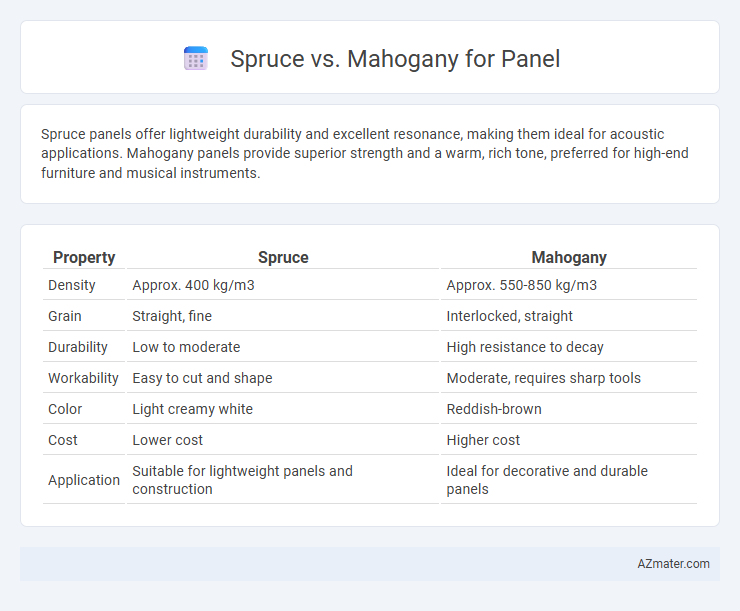Spruce panels offer lightweight durability and excellent resonance, making them ideal for acoustic applications. Mahogany panels provide superior strength and a warm, rich tone, preferred for high-end furniture and musical instruments.
Table of Comparison
| Property | Spruce | Mahogany |
|---|---|---|
| Density | Approx. 400 kg/m3 | Approx. 550-850 kg/m3 |
| Grain | Straight, fine | Interlocked, straight |
| Durability | Low to moderate | High resistance to decay |
| Workability | Easy to cut and shape | Moderate, requires sharp tools |
| Color | Light creamy white | Reddish-brown |
| Cost | Lower cost | Higher cost |
| Application | Suitable for lightweight panels and construction | Ideal for decorative and durable panels |
Overview: Spruce vs Mahogany for Panels
Spruce panels offer lightweight durability with a fine, straight grain that enhances acoustic properties, making them ideal for musical instruments and interior applications requiring resonance. Mahogany panels provide exceptional strength, rich reddish-brown color, and superior workability, often favored for high-end furniture and decorative wall treatments. Both woods perform well in panels, but spruce excels in sound-related uses, while mahogany stands out for its aesthetic appeal and long-lasting structural integrity.
Wood Origin and Characteristics
Spruce, primarily sourced from North American and European forests, is known for its lightweight, straight-grained texture and excellent resonance, making it ideal for soundboards and paneling applications requiring sound amplification. Mahogany, originating mainly from Central and South America, features a denser composition with a rich reddish-brown color and deep, interlocked grain patterns that offer superior durability and a luxurious finish for decorative panels. Both woods provide distinct aesthetic and structural advantages, with spruce emphasizing acoustic properties and mahogany excelling in longevity and visual appeal.
Appearance and Grain Patterns
Spruce panels feature a light, creamy color with a straight, fine grain pattern that creates a clean, uniform appearance ideal for modern or minimalist designs. Mahogany panels showcase a rich, reddish-brown hue with interlocking, wavy grain that adds depth and warmth, enhancing traditional or luxurious interiors. The contrasting grain patterns and color tones between spruce and mahogany significantly influence the visual texture and aesthetic appeal of wood paneling projects.
Density and Weight Comparison
Spruce wood typically has a density ranging from 380 to 450 kg/m3, making it lighter and easier to handle compared to mahogany, which has a density of approximately 600 to 850 kg/m3. The lower density of spruce translates to reduced panel weight, ideal for applications requiring lightweight materials without sacrificing strength. Mahogany's higher density provides superior durability and resistance to impact, but it results in heavier panels that may require additional structural support.
Strength and Durability Factors
Spruce offers a lightweight yet strong option for paneling, prized for its excellent strength-to-weight ratio and resistance to bending, making it suitable for structural applications. Mahogany is renowned for its superior durability, natural resistance to decay, and exceptional hardness, providing long-lasting performance in high-wear environments. When prioritizing strength and durability, mahogany outperforms spruce by offering enhanced stability, resistance to warping, and longevity in demanding conditions.
Acoustic Properties: Tone and Resonance
Spruce offers a bright, clear tone with excellent resonance, making it a preferred choice for soundboards in musical instruments due to its high stiffness-to-weight ratio. Mahogany delivers a warmer, richer sound with pronounced midrange frequencies, favored for its density and ability to produce a balanced, mellow tone. Panels constructed from spruce emphasize clarity and projection, while mahogany panels provide depth and warmth, influencing the overall acoustic quality in architectural or musical applications.
Workability and Ease of Use
Spruce offers superior workability due to its lightweight and soft texture, making it easier to cut, shape, and sand for panel applications. Mahogany, while denser and harder than spruce, provides smooth finishes and excellent stability but requires more effort and sharper tools for precision work. Choosing spruce enhances ease of use for intricate detailing, whereas mahogany excels in durability and long-term performance in paneling projects.
Cost and Market Availability
Spruce offers a more cost-effective option for paneling, with prices significantly lower than mahogany, making it ideal for budget-conscious projects. Mahogany commands higher prices due to its durability, rich appearance, and limited supply, which also affects market availability. Spruce is widely available as a softwood in large quantities, while mahogany's availability is restricted by environmental regulations and slower growth rates.
Ideal Applications: Spruce vs Mahogany
Spruce is ideal for soundboards and structural panels in musical instruments due to its lightweight and excellent resonance properties, making it popular for guitars and pianos. Mahogany, favored for its durability and attractive grain, is perfect for decorative panels, furniture, and cabinetry where strength and aesthetic appeal are crucial. Both woods offer distinct advantages, with spruce emphasizing acoustic performance and mahogany providing robust structural integrity and rich visual warmth.
Choosing the Right Wood for Your Panels
Spruce offers lightweight strength and excellent acoustic properties, making it ideal for soundboards and lightweight paneling, while mahogany provides dense, durable, and visually rich panels suitable for high-end furniture and cabinetry. Selecting the right wood depends on the panel's intended use; spruce excels in applications requiring resonance and flexibility, whereas mahogany is better for structural stability and elegant finishes. Consider factors like durability, grain pattern, and moisture resistance to ensure the panel meets functional and aesthetic demands.

Infographic: Spruce vs Mahogany for Panel
 azmater.com
azmater.com